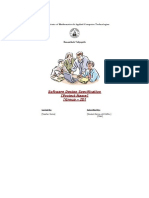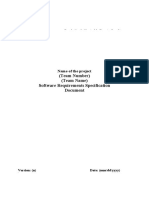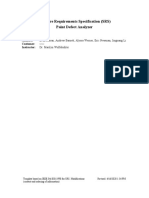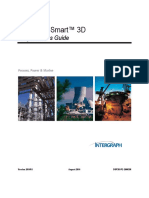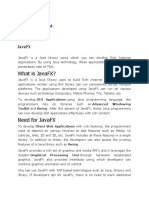Session: 2014 - 2016
Session: 2014 - 2016
Uploaded by
aqibCopyright:
Available Formats
Session: 2014 - 2016
Session: 2014 - 2016
Uploaded by
aqibOriginal Description:
Original Title
Copyright
Available Formats
Share this document
Did you find this document useful?
Is this content inappropriate?
Copyright:
Available Formats
Session: 2014 - 2016
Session: 2014 - 2016
Uploaded by
aqibCopyright:
Available Formats
21.03.
2016
Session: 2014 - 2016 | <CS&IT/IUB>
Project Title
Revision History
Date
<date>
Description
<Version 1.0>
Author
Comments
<Noreen Anjum>
<First Revision>
Document Approval
The following Software Requirements Specification has been accepted and approved by the following:
Signature
Printed Name
Dr. Mamoona Asghar
Title
Supervisor, CSIT 21306
Date
<date>
Project Title
Table of Contents
1. Introduction
1.1 Purpose
1.2 Scope
1.3 Definitions, Acronyms, and Abbreviations.
1.4 References
1.5 Overview
2. The Overall Description
2.1 Product Perspective
2.1.1 Operations
2.1.2 Site Adaptation Requirements
2.2 Product Functions
2.3 User Characteristics
2.4 General Constraints
2.5 Assumptions and Dependencies
3. Specific Requirements
3.1 External Interface Requirements
3.1.1 System Interfaces
3.1.2 Interfaces
3.1.3 Hardware Interfaces
3.1.4 Software Interfaces
3.1.5 Communications Interfaces
3.2 Functional Requirements
3.2.1 <Functional Requirement or Feature #1>
3.2.2 <Functional Requirement or Feature #2>
3.3 Use Cases
3.3.1 Use Case #1
3.3.2 Use Case #2
3.4 Classes / Objects
3.4.1 <Class / Object #1>
3.4.2 <Class / Object #2>
3.5 Non-Functional Requirements
3.5.1 Performance
3.5.2 Reliability
3.5.3 Availability
3.5.4 Security
3.5.5 Maintainability
3.5.6 Portability
3.6 Inverse Requirements
3.7 Logical Database Requirements
3.8 Design Constraints
Project Title
3.8.1 Standards Compliance
4. Analysis Models
4.1 Sequence Diagrams
4.2 Data Flow Diagrams (DFD)
4.3 State-Transition Diagrams (STD)
5. Supporting Information
Appendix A Background Research on:
Appendix B Data Dictionary
Project Title
1. Introduction
This document is used to gather and analyze and give an overview inside of the complete
Home Appliances Sales Management System by defining the problems in detail.
This document contain complete requirements, context diagram, generating bill and detail
of a stock and sales management system.
1.1 Purpose
The basic purpose of this system, sales of (HASMS) to particular customer who need the
affordable home appliances item like washing machine, microwave Oven, and
refrigerator etc. And also made the bill of sale item for provide the facilities of seller and
customer parties.
1.2 Scope
(1) This software about sales management of home appliances inside shop but
doesnt provide online sales system.
(2) This Software only deals with cash base system not credit bases.
(3) This software replace manual system of sales.
(4) In this system record of customer stored and maintained according to the
updating.
(5) In this software administrator must login and provide access locally.
(6) This software update stock automatically after sales and also purchase.
(7) It contains affordable hardware and storage not so costly.
1.3 Definitions, Acronyms, and Abbreviations.
Sale:
Stock:
and
Sale is the exchange of commodity for money from seller and buyer.
The goods that are kept on shop or warehouse and available for sale
Distribution.
Purchase:
SRS:
HASMS: Home Appliances Sales Management System.
Software Requirement Specification.
SRS Document 1.0
Page 1 of 9
03/19/16
Project Title
1.4 References
In this subsection:
(1) Provide a complete list of all documents referenced elsewhere in the SRS
(2) Identify each document by title, report number (if applicable), date, and
publishing organization
(3) Specify the sources from which the references can be obtained.
This information can be provided by reference to an appendix or to another document. If
your application uses specific protocols or RFCs, then reference them here so designers
know where to find them.
1.5 Overview
This SRS consists of three sections. First one is introductory about the system over all.
Second subsection about general factors and an overview of this SRS explain general
constraints of system under which would be developed. Third subsection of this SRS is
all about detailed description of the system in the form of functional and non-functional
requirements. And at the end of the third subsection a use case diagram represent
structure of the system.
2. The Overall Description
Making this software first achievement is manage sales data. Many number of items
available at store and which item from these have to be sold out, then stock updated after
sales automatically. In this system keep track of any item thats stock become zero,
system would inform to manager automatically.
Login Screen
Main
Supplier/man
ager
Stock menu
Updat
e
Inform
Manag
e
View
Purchase
menu
Sales menu
Sold
Check
profit/loss
Logout
Purcha
se
Profit
Return
Loss
Return
View
Figure # 1: Block Diagram of Complete System (HASMS).
SRS Document 1.0
Page 2 of 9
03/19/16
Project Title
2.1 Product Perspective
This system (HASMS) is totally independent and a stand-alone system. This system is
not a component of another large system. It is self-contained system. Managing sales
system, stock system and purchasing for further sales. This system would become a
reason of change of manual system into computerized system.
The following subsections describe how the software operates inside various constraints.
2.1.1 Operations
This (SRS) consists of the following operations:
(1) This SRS contain different diagrams for describing complete system functionality.
(2) Our system would contain main window from where you can choose different menus like
sales, stock etc.
(3) This system capable of updating record of sale.
(4) This SRS specify that our system would be generating bill of items to be sold.
(5) This SRS also describe that our system would be capable of delete record automatically
which to be sold.
(6) When Owner purchase stock then manager makes software entries.
(7) Our system would perform another functionality of checking current balance i.e. profit or
loss only by owner.
(8) Stock Controls by Owner, its access all up to owner.
(9) Sales controls by supplier/manager.
(10) Customer can be viewed and selected items.
2.1.2 Site Adaptation Requirements
In this section:
(1) Define the requirements for any data or initialization sequences that are specific to a
given site, mission, or operational mode
(2) Specify the site or mission-related features that should be modified to adapt the software
to a particular installation
If any modifications to the customers work area would be required by your system, then
document that here. For instance, A 100Kw backup generator and 10000 BTU air
conditioning system must be installed at the user site prior to software installation.
This could also be software-specific like, New data tables created for this system must
be installed on the companys existing DB server and populated prior to system
activation. Any equipment the customer would need to buy or any software setup that
needs to be done so that your system will install and operate correctly should be
documented here.
SRS Document 1.0
Page 3 of 9
03/19/16
Project Title
2.2 Product Functions
Provide a summary of the major functions that the software will perform. Sometimes the
function summary that is necessary for this part can be taken directly from the section of
the higher-level specification (if one exists) that allocates particular functions to the
software product.
For clarity:
(1) The functions should be organized in a way that makes the list of functions understandable to
the customer or to anyone else reading the document for the first time.
(2) Textual or graphic methods can be used to show the different functions and their
relationships. Such a diagram is not intended to show a design of a product but simply shows
the logical relationships among variables.
AH, finally the real meat of section 2. This describes the functionality of the system in
the language of the customer. What specifically does the system that will be designed
have to do? Drawings are good, but remember this is a description of what the system
needs to do, not how you are going to build it. (That comes in the design document).
2.3 User Characteristics
Describe those general characteristics of the intended users of the product including
educational level, experience, and technical expertise. Do not state specific requirements
but rather provide the reasons why certain specific requirements are later specified in
section 3.
What is it about your potential user base that will impact the design? Their experience
and comfort with technology will drive UI design. Other characteristics might actually
influence internal design of the system.
2.4 General Constraints
Provide a general description of any other items that will limit the developer's options.
These can include:
(1) Regulatory policies
(2) Hardware limitations (for example, signal timing requirements)
(3) Interface to other applications
(4) Parallel operation
(5) Audit functions
(6) Control functions
(7) Higher-order language requirements
(8) Signal handshake protocols (for example, XON-XOFF, ACK-NACK)
(9) Reliability requirements
(10) Criticality of the application
(11) Safety and security considerations
This section captures non-functional requirements in the customers language. A more
formal presentation of these will occur in section 3.
SRS Document 1.0
Page 4 of 9
03/19/16
Project Title
2.5 Assumptions and Dependencies
List each of the factors that affect the requirements stated in the SRS. These factors are
not design constraints on the software but are, rather, any changes to them that can affect
the requirements in the SRS. For example, an assumption might be that a specific
operating system would be available on the hardware designated for the software product.
If, in fact, the operating system were not available, the SRS would then have to change
accordingly.
This section is catch-all for everything else that might influence the design of the system
and that did not fit in any of the categories above.
3. Specific Requirements
This will be the largest and most important section of the SRS. The customer
requirements will be embodied within Section 2, but this section will give the Drequirements that are used to guide the projects software design, implementation, and
testing.
Each requirement in this section should be:
Correct
Traceable (both forward and backward to prior/future artifacts)
Unambiguous
Verifiable (i.e., testable)
Prioritized (with respect to importance and/or stability)
Complete
Consistent
Uniquely identifiable (usually via numbering like 3.4.5.6)
Attention should be paid to the carefully organize the requirements presented in this
section so that they may easily accessed and understood. Furthermore, this SRS is not
the software design document, therefore one should avoid the tendency to over-constrain
(and therefore design) the software project within this SRS.
3.1 External Interface Requirements
3.1.1 System Interfaces
This system (HASMS) have many interfaces. The system that we are going to develop
would be a user login page at first. When admin enter own id and password then he
allowed to use the system. After login into the software (HASMS) there will be a main
menu where you can choose the sales menu, stock information menu, and purchase stock
menu. Our main objective of this system is to maintain sales, purchase and also stock.
This system not provide the online interface. It provide you only a desktop system
interface.
SRS Document 1.0
Page 5 of 9
03/19/16
Project Title
3.1.2 Interfaces
Specify:
(1) The logical characteristics of each interface between the software product and its users.
(2) All the aspects of optimizing the interface with the person who must use the system
This is a description of how the system will interact with its users. Is there a GUI, a
command line or some other type of interface? Are there special interface requirements?
If you are designing for the general student population for instance, what is the impact of
ADA (American with Disabilities Act) on your interface?
3.1.3 Hardware Interfaces
Specify the logical characteristics of each interface between the software product and the
hardware components of the system. This includes configuration characteristics. It also
covers such matters as what devices are to be supported, how they are to be supported
and protocols. This is not a description of hardware requirements in the sense that This
program must run on a Mac with 64M of RAM. This section is for detailing the actual
hardware devices your application will interact with and control. For instance, if you are
controlling X10 type home devices, what is the interface to those devices? Designers
should be able to look at this and know what hardware they need to worry about in the
design. Many business type applications will have no hardware interfaces. If none, just
state The system has no hardware interface requirements If you just delete sections
that are not applicable, then readers do not know if: a. this does not apply or b. you
forgot to include the section in the first place.
3.1.4 Software Interfaces
Specify the use of other required software products and interfaces with other application
systems. For each required software product, include:
(1)
(2)
(3)
(4)
(5)
Name
Mnemonic
Specification number
Version number
Source
For each interface, provide:
(1) Discussion of the purpose of the interfacing software as related to this software product
(2) Definition of the interface in terms of message content and format
Here we document the APIs, versions of software that we do not have to write, but that
our system has to use. For instance if your customer uses SQL Server 7 and you are
required to use that, then you need to specify i.e.
3.1.4.1 Microsoft SQL Server 7
The system must use SQL Server as its database component. Communication with the
DB is through ODBC connections. The system must provide SQL data table definitions
to be provided to the company DBA for setup.
SRS Document 1.0
Page 6 of 9
03/19/16
Project Title
A key point to remember is that you do NOT want to specify software here that you think
would be good to use. This is only for customer-specified systems that you have to
interact with. Choosing SQL Server 7 as a DB without a customer requirement is a
Design choice, not a requirement. This is a subtle but important point to writing good
requirements and not over-constraining the design.
3.1.5 Communications Interfaces
Specify the various interfaces to communications such as local network protocols, etc.
These are protocols you will need to directly interact with. If you happen to use web
services transparently to your application then do not list it here. If you are using a
custom protocol to communicate between systems, then document that protocol here so
designers know what to design. If it is a standard protocol, you can reference an existing
document or RFC.
3.2 Functional Requirements
This section describes specific features of the software project. If desired, some
requirements may be specified in the use-case format and listed in the Use Cases Section.
3.2.1 <Functional Requirement or Feature #1>
3.2.1.1 Introduction
3.2.1.2 Inputs
3.3 Use Cases
This section of given SRS consists of use cases in form of separate actor with
functionalities.
3.3.1 Use Case #1 for login owner
Login
Owner
SRS Document 1.0
Error
Welcome
Page 7 of 9
03/19/16
Project Title
3.3.1.1 Use case components:
(1) ID:
(2) Name:
(3) Description:
will record with
HASMS-1
Login
User will login to prevent unauthorized access and any activity
Name.
(4) Actor:
(5) Pre-condition:
(6) Basic Flow:
Owner/ User
Must be register.
1. User enter name and password.
2. System will generate query.
3. Query send to database.
4. If result is valid move to account
Else
Move to error.
(7) Alternate Flow:
1.system read cookies.
2. Generate query.
3. Send it to database.
4. If result is valid, move to account
Else
Move to error.
(8) Post-condition: user on account.
(9) Exception:
Disconnection from network.
3.3.2 Use Case # 2 for owner functionality
Purchase
stock
SRS Document 1.0
Page 8 of 9
03/19/16
Project Title
Business
improve
Payment for
stock
Check profit
Check loss
Return stock
Owner
3.3.2.1 Use case components:
(1) ID:
HASMS-2
(2) Name:
owners work
(3) Description:
owner perform these functionalities because he is an in
charge of the stock.
(4) Actor:
Owner/ User
(5) Pre-condition:
activities.
Owner must be have enough stock to manage all these
(6) Basic Flow:
on the software.
1. Owner/user will perform any of above mentioned tasks
2. System will generate query.
3. Query send to database.
4. If result is valid perform any task i.e. purchase stock,
payment for stock etc.
Else
Move to error.
(7) Alternate Flow:
1. Owner want to check profit or loss.
2. Generate query.
3. Send it to database.
4. If result is valid, move to the result.
Else
SRS Document 1.0
Page 9 of 9
03/19/16
Project Title
Move to error.
(8) Post-condition: user on account which he desire.
(9) Exception:
Disconnection from network.
3.3.3 Use Case #3 for Supplier / Manager
Sale goods
Sale report
Reorder item
short
Supplier/Manager
Inform
owner
3.3.3.1 Use case components:
(1) ID:
(2) Name:
HASMS-3
sales and management.
(3) Description:
supplier responsible for sale and generating reports and
inform owner if any item
Short in the stock.
(4) Actor:
(5) Pre-condition:
data to owner.
(6) Basic Flow:
SRS Document 1.0
Supplier / Manager
Supplier sold items and generating reports for owner send
1. Supplier/manager will perform these tasks.
Page 10 of 9
03/19/16
Project Title
2. System will generate query.
3. Query send to database.
4. If result is valid perform any task i.e. sold item,
reorder etc.
Else
Move to error.
(7) Alternate Flow:
1. Manager want to inform owner if items to be short.
2. Generate query.
3. Send it to database.
4. If result is valid, move to the result.
Else
Move to error.
(8) Post-condition: Manager perform his routine wise tasks.
(9) Exception:
Disconnection from network.
3.3.4 Use Case #4 for Customer
Show all
items
Purchase
selected
Customer
SRS Document 1.0
Pay for item
Page 11 of 9
03/19/16
Project Title
3.3.4.1 Use case components:
(1) ID:
(2) Name:
(3) Description:
only selected items.
(4) Actor:
(5) Pre-condition:
(6) Basic Flow:
HASMS-4
sales.
customer can view all items put at the shop and purchase
customer
items must be available at the shop.
1. Customer demand for an item.
2. System will generate query.
3. Query send to database.
4. If result is valid item would be available.
Else
Move to error.
(7) Alternate Flow:
1. Customer want another items may be more than one.
2. Generate query.
3. Send it to database.
4. If result is valid, move to other items.
Else
Move to error.
(8) Post-condition: if customer want to buy then pay for the item.
(9) Exception:
Disconnection from network
3.3.5 Use Case #5 for Distributer
Pay for item
Pay for item
Pay for item
SRS Document 1.0
Page 12 of 9
03/19/16
Project Title
Distributer
3.3.5.1 Use case components:
(1) ID:
HASMS-5
(2) Name:
purchase for stock.
(3) Description:
Distributer distribute appliances at different shops.
(4) Actor:
distributer
(5) Pre-condition:
Dawlance.
distributer must have appliances from Company like Haier,
(6) Basic Flow:
1. Owner purchase items from distributer.
2. Owner will into new software entries.
3. Queries send to database.
4. If all necessary conditions fulfill then entries added
successful.
Else
Move to error.
(7) Alternate Flow:
1. Owner want to purchase Philips product.
2. Then generate query accordingly.
3. Send it to database.
4. If all necessary conditions fulfill then entries added
successful.
Else
Move to error.
(8) Post-condition:
(9) Exception:
owner pay against purchasing.
Disconnection from network.
3.4 Classes / Objects
This section contains major classes of the ------------------------ system.
SRS Document 1.0
Page 13 of 9
03/19/16
Project Title
3.4.1 <Class / Object #1>
3.4.1.1 Attributes
3.4.1.2 Functions
<Reference to functional requirements and/or use cases>
3.4.2 <Class / Object #2>
3.5 Non-Functional Requirements
Non-functional requirements emergent properties relate to the behavior of the system that
we are going to develop as its operational environment. This system of (HASMS) have
appropriate non-functional requirements. Usability, reliability, performance, database
requirements, availability, security, maintainability, portability, and design constraints all
these non-functional requirements performed by our system.
3.5.1 Usability
3.5.1.1 Graphical User Interface
This system provide icons and toolbars for better understanding.
This system provide a uniform look and feel between all the forms of
application.
This system provide an image of each product in the catalog.
3.5.2 Performance
3.5.2.1 Response time
This requirement provide acceptable response time for the system functionality.
At the load time, system response within five seconds, otherwise within two
seconds.
And database queries response time within six to seven seconds.
3.5.2.2 Capacity
All jobs scheduled by the number of capacity of nodes. In (HASMS) no upper limit to
inherit jobs.
3.5.2.3 Cost
Under all circumstances, all cost charged by the user to achieve better
performance.
SRS Document 1.0
Page 14 of 9
03/19/16
Project Title
3.5.3 Reliability / Availability
These requirements reliability and availability totally about system state, if our
system would be down then its recovery would be in two minutes.
3.5.4 Security
To protect the system from unauthorized users, we set the username and password.
If user name and password will be incorrect then user cant access system.
3.5.5 Maintainability
Maintainability also called flexibility.
3.5.5.1 Maximum bug rate
There will be a maximum time of 1 bug in 1/100 part of one second.
3.5.5.2 Maximum time to repair
If any error and bugs occur in our system, there will be sufficient time to remove it.
3.5.6 Supportability
3.5.6.1 Naming convention
Coding of all project in our software written as specified naming convention.
3.5.6.2 Coding standards
All code in this system will be written by the GNU General Purpose License.
3.6 Inverse Requirements
State any *useful* inverse requirements.
3.7 Logical Database Requirements
This section specifies the logical requirements for any information that is to be placed
into a database. This may include:
Types of information used by various functions
Frequency of use
Accessing capabilities
Data entities and their relationships
Integrity constraints
Data retention requirements
If the customer provided you with data models, those can be presented here. ER
diagrams (or static class diagrams) can be useful here to show complex data relationships.
Remember a diagram is worth a thousand words of confusing text.
SRS Document 1.0
Page 15 of 9
03/19/16
Project Title
3.8 Design Constraints
Specify design constraints that can be imposed by other standards, hardware limitations,
etc.
3.8.1 Standards Compliance
Specify the requirements derived from existing standards or regulations. They might
include:
(1) Report format
(2) Data naming
(3) Accounting procedures
(4) Audit Tracing
For example, this could specify the requirement for software to trace processing activity.
Such traces are needed for some applications to meet minimum regulatory or financial
standards. An audit trace requirement may, for example, state that all changes to a
payroll database must be recorded in a trace file with before and after values.
4. Analysis Models:
System models are used in this SRS for developing an abstract view
of HASMS. Analysis of
This SRS described by drawing sequence diagrams of the system. It
represent individual
System diagrammatically (in sequence form) not complete system as a
whole.
4.1 Sequence Diagram for Owner:
SRS Document 1.0
Page 16 of 9
03/19/16
Project Title
Owner
Current condition
View information
Contact
Distributer
Stock
Purchase Stock
Check quality
report from stock info
Demand to distributer
pay for purchase
Return bad quality
login
If correct id & password
Else incorrect
check stock info
error message
4.2 Sequence Diagram for Supplier / Manager:
In this sequence diagram show all working of supplier.
Supplier / Manager
SRS Document 1.0
Sale goods
DB connection
Reorder items
Page 17 of 9
Contact owner
03/19/16
Project Title
Demand goods
generate reports
Another items
if item short
inform owner
4.3 Sequence Diagram for customer:
Customer
View / show
items
View all items
Selected items
Purchase only
select
Record saved
Some to be selected
Payment of interchanging
Save
record into database
4.4 Sequence Diagram for distributer:
SRS Document 1.0
Page 18 of 9
03/19/16
Project Title
Distributer
Dalliance
Haier
Philips
Demand for dalliance
Demand for Haier
Demand for Philips
5. Supporting Information
Appendix A Background Research on:
Topic 1
Topic 2
Topic 3
Topic n
Appendix B Data Dictionary
SRS Document 1.0
Page 19 of 9
03/19/16
You might also like
- Sample IT Operational ManualDocument11 pagesSample IT Operational ManualArthur Ekow100% (1)
- SRS TemplateDocument25 pagesSRS TemplateRomeoNo ratings yet
- SRS On Online Billing and Stocking ManagementDocument16 pagesSRS On Online Billing and Stocking Managementrashivadekar_nitish100% (1)
- SRS - How to build a Pen Test and Hacking PlatformFrom EverandSRS - How to build a Pen Test and Hacking PlatformRating: 2 out of 5 stars2/5 (1)
- Type3 EngDocument350 pagesType3 Engjohnik3316No ratings yet
- Title of The Project: Software Requirements Specifications DocumentDocument10 pagesTitle of The Project: Software Requirements Specifications Documentssaauu1010No ratings yet
- Software Requirements Specification (SRS) TemplateDocument27 pagesSoftware Requirements Specification (SRS) TemplateKapilNo ratings yet
- SRSPLMDocument7 pagesSRSPLMTawqeer MunshiNo ratings yet
- SRS Document TemplateDocument13 pagesSRS Document Templatemu70832No ratings yet
- SRS Document TemplateDocument13 pagesSRS Document TemplateYuniarti NiaNo ratings yet
- Free ChargeDocument6 pagesFree ChargeAbhilash MishraNo ratings yet
- Chapter 3 Srs TemplateDocument12 pagesChapter 3 Srs TemplateFidelis Yu RiNo ratings yet
- Software Requirements Specification (SRS) Template: 1.1 PurposeDocument15 pagesSoftware Requirements Specification (SRS) Template: 1.1 Purposemeha9924No ratings yet
- SRS TEmplate ExampleDocument30 pagesSRS TEmplate Examplenanda kumar dsNo ratings yet
- CS330 Software Engineering: Software Requirements Specifications DocumentDocument29 pagesCS330 Software Engineering: Software Requirements Specifications DocumentSumant LuharNo ratings yet
- SRS&SDS Format WithDetailedPoints 083013Document20 pagesSRS&SDS Format WithDetailedPoints 083013Arusi KumariNo ratings yet
- Software Requirements Specification: Mini Project KCS-354Document5 pagesSoftware Requirements Specification: Mini Project KCS-354Shubham GuptaNo ratings yet
- SRS Template ProjectDocument19 pagesSRS Template ProjectAmit SawantNo ratings yet
- SRS Template ProjectDocument19 pagesSRS Template ProjectAnkitShingalaNo ratings yet
- SRS PDFDocument72 pagesSRS PDFTuhin MahatoNo ratings yet
- SRS Document GuidelinesDocument22 pagesSRS Document GuidelinesRaj Kumar ThapaNo ratings yet
- Srs Project On StockDocument12 pagesSrs Project On Stockaamitcoool100% (2)
- SRS BoutiqueDocument21 pagesSRS BoutiqueM.Basit Rahim100% (1)
- System Requirements Specification GuideDocument4 pagesSystem Requirements Specification GuideDaisy WanguiNo ratings yet
- Software Requirements Specifications DocumentDocument30 pagesSoftware Requirements Specifications DocumentRavinder KambojNo ratings yet
- SRS4 0Document30 pagesSRS4 0Moses MNo ratings yet
- Software Requirements Specifications DocumentDocument30 pagesSoftware Requirements Specifications DocumentSwarupa PallavNo ratings yet
- 21068.SRS TemplateDocument16 pages21068.SRS TemplateShubhkarman Singh SandhuNo ratings yet
- Software Requirements Specifications DocumentDocument29 pagesSoftware Requirements Specifications DocumentsureshravNo ratings yet
- Lab Manual 01 CSE 406 Integrated Design Project IIDocument10 pagesLab Manual 01 CSE 406 Integrated Design Project IIafnan mafujNo ratings yet
- Sushant Lab File SEDocument30 pagesSushant Lab File SESushant SharmaNo ratings yet
- Requirements AnalysisDocument8 pagesRequirements AnalysisRajesh VhadlureNo ratings yet
- Software Requirements Specification : Group NumberDocument5 pagesSoftware Requirements Specification : Group NumberMAMTA YADAVNo ratings yet
- SoftwareRequirementsSpecifications (Template)Document10 pagesSoftwareRequirementsSpecifications (Template)Harshavardhan BoopathiNo ratings yet
- Se UnitDocument35 pagesSe Unit2020pitcse278No ratings yet
- SRS Template ExampleDocument16 pagesSRS Template ExampleabcNo ratings yet
- System Requirements Specification DocumentDocument5 pagesSystem Requirements Specification DocumentEbbyNo ratings yet
- SRS Template Based On IEEEDocument30 pagesSRS Template Based On IEEEDataArt EnjoyItNo ratings yet
- SRSDocument13 pagesSRSKrunal ZalavadiyaNo ratings yet
- Lab Manual Software Engineering & Project Management: List of ExperimentDocument52 pagesLab Manual Software Engineering & Project Management: List of Experimentshubh agrawalNo ratings yet
- Project Name : System Requirement SpecificationDocument13 pagesProject Name : System Requirement Specificationtakne_007No ratings yet
- Software Requirement SpecificationDocument10 pagesSoftware Requirement SpecificationAyush Agrawal0% (1)
- CMS SRSDocument13 pagesCMS SRSMohd ImranNo ratings yet
- Assignment 2 SEDocument6 pagesAssignment 2 SERozan ManandharNo ratings yet
- Solution SRS ProjectDocument11 pagesSolution SRS ProjectNisha BaruwalNo ratings yet
- 1 Functional Specification TemplateDocument9 pages1 Functional Specification TemplatestomilsonNo ratings yet
- Software Requirements Specification (SRS) : Sixth Sense Marketing Private LimitedDocument19 pagesSoftware Requirements Specification (SRS) : Sixth Sense Marketing Private LimitedasdfqwerNo ratings yet
- Srs Template IeeeDocument6 pagesSrs Template IeeeAshishNo ratings yet
- Final SRS ContentsDocument5 pagesFinal SRS ContentsSurabhi GuptaNo ratings yet
- Current Environment: Background of The Study System Objectives Significance of The Study ProposalDocument3 pagesCurrent Environment: Background of The Study System Objectives Significance of The Study ProposalGene Kyle SardidoNo ratings yet
- Software Requirements Specification (SRS) TemplateDocument29 pagesSoftware Requirements Specification (SRS) Templatesabir riazNo ratings yet
- CH-2 IEEE Standards For SRSDocument14 pagesCH-2 IEEE Standards For SRSprathamesh Girish AkkatangerhalNo ratings yet
- Automated Paint Defect AnalyserDocument23 pagesAutomated Paint Defect AnalyserAmal 123No ratings yet
- Embedded Systems Programming with C++: Real-World TechniquesFrom EverandEmbedded Systems Programming with C++: Real-World TechniquesNo ratings yet
- Software Testing Interview Questions You'll Most Likely Be AskedFrom EverandSoftware Testing Interview Questions You'll Most Likely Be AskedNo ratings yet
- Auditing Cloud Computing: A Security and Privacy GuideFrom EverandAuditing Cloud Computing: A Security and Privacy GuideRating: 3 out of 5 stars3/5 (2)
- Computer Science Self Management: Fundamentals and ApplicationsFrom EverandComputer Science Self Management: Fundamentals and ApplicationsNo ratings yet
- 50 Networking Interview Questions and Answers - Sreesankar 20511Document8 pages50 Networking Interview Questions and Answers - Sreesankar 20511Sree SankarNo ratings yet
- Chapter 2a: Operating-System Services: Silberschatz, Galvin and Gagne ©2018 Operating System Concepts - 10 EditionDocument35 pagesChapter 2a: Operating-System Services: Silberschatz, Galvin and Gagne ©2018 Operating System Concepts - 10 Edition100SIDDHANT CHANDNANo ratings yet
- Maxwell Brochure PDFDocument2 pagesMaxwell Brochure PDFERNESTONo ratings yet
- Humanities Interface TheoryDocument20 pagesHumanities Interface TheoryJohn TinnellNo ratings yet
- STI03 Customizing ToolbarDocument5 pagesSTI03 Customizing ToolbarVenkata NarayanaNo ratings yet
- Ameranth v. NAAMA Networks Et. Al.Document14 pagesAmeranth v. NAAMA Networks Et. Al.PriorSmartNo ratings yet
- Globalprotect App User GuideDocument178 pagesGlobalprotect App User GuideRodrigo CostaNo ratings yet
- Helion ISP Demo Quick StartDocument13 pagesHelion ISP Demo Quick StartSovi SoviNo ratings yet
- Introduction To Human ComputerDocument23 pagesIntroduction To Human ComputernopeyoufoolNo ratings yet
- Linux System Administration: Linux Professional Institute (LPI) Certification Level 1 Exam 101Document76 pagesLinux System Administration: Linux Professional Institute (LPI) Certification Level 1 Exam 101shafvpNo ratings yet
- UserDocument397 pagesUserHugoNo ratings yet
- Kivy - Interactive Applications and Games in Python - Second Edition - Sample ChapterDocument35 pagesKivy - Interactive Applications and Games in Python - Second Edition - Sample ChapterPackt PublishingNo ratings yet
- PLA Series - Users Manual-EeglishDocument73 pagesPLA Series - Users Manual-Eeglishb4suraNo ratings yet
- RuggedExplorer User GuideDocument46 pagesRuggedExplorer User GuideRoberto GarridoNo ratings yet
- SP 3 Dprogguide 082014-1Document70 pagesSP 3 Dprogguide 082014-1scleeNo ratings yet
- User Interface Design of Digital Textbooks: Elena Aurel RaileanDocument108 pagesUser Interface Design of Digital Textbooks: Elena Aurel RaileanCarolina Medina DeLargeNo ratings yet
- Unit 5: Computer Software I. Vocabulary and Pronunciation Match English Terms and Vietnamese Translations English VietnameseDocument6 pagesUnit 5: Computer Software I. Vocabulary and Pronunciation Match English Terms and Vietnamese Translations English VietnameseTuấn NguyễnNo ratings yet
- Sse 213Document16 pagesSse 213Dan Ochieng Jr.No ratings yet
- Ryk-9267 DVRDocument1 pageRyk-9267 DVRtiby_olimpNo ratings yet
- FDT/DTM Framework For New Field Device Tools: TAKEUCHI TetsuoDocument4 pagesFDT/DTM Framework For New Field Device Tools: TAKEUCHI TetsuovishadkapadiaNo ratings yet
- Isight 55 DatasheetDocument2 pagesIsight 55 DatasheethullNo ratings yet
- The HP 48 Programmers ToolkitDocument130 pagesThe HP 48 Programmers Toolkitelmacuarro5No ratings yet
- Windows 98Document4 pagesWindows 98SUPERNOVAKHANNo ratings yet
- Advanced Control Systems For ESP 3Document97 pagesAdvanced Control Systems For ESP 3balajiesp05100% (1)
- Technologies Used JavaFx MysqlDocument31 pagesTechnologies Used JavaFx MysqlAIMEN NAAZ SHAHEENNo ratings yet
- 9 Ed., Prentice HallDocument51 pages9 Ed., Prentice HallGangadhar MamadapurNo ratings yet
- ISDocument67 pagesISpal.signNo ratings yet
- Operate A Personal Computer PDFDocument56 pagesOperate A Personal Computer PDFEdgar G. Dela Rosa0% (1)
- How To Integrate A SAP Conversational AI Chatbot With SAP GUIDocument11 pagesHow To Integrate A SAP Conversational AI Chatbot With SAP GUIkoizak3No ratings yet
















